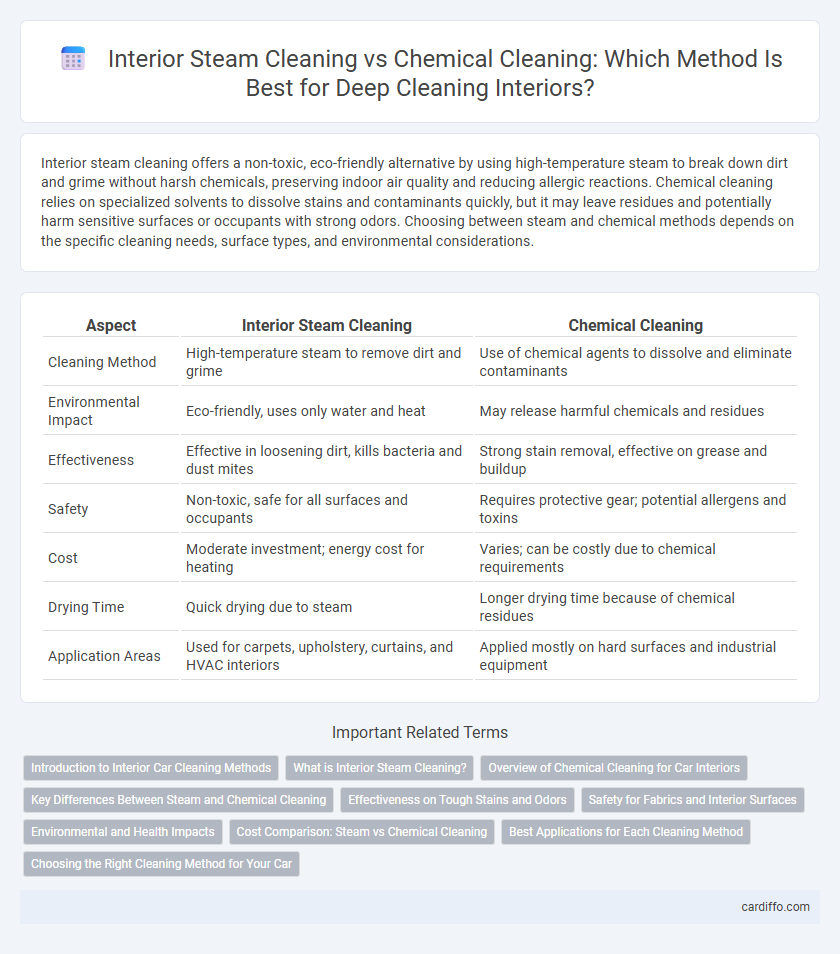Interior steam cleaning offers a non-toxic, eco-friendly alternative by using high-temperature steam to break down dirt and grime without harsh chemicals, preserving indoor air quality and reducing allergic reactions. Chemical cleaning relies on specialized solvents to dissolve stains and contaminants quickly, but it may leave residues and potentially harm sensitive surfaces or occupants with strong odors. Choosing between steam and chemical methods depends on the specific cleaning needs, surface types, and environmental considerations.
Table of Comparison
| Aspect | Interior Steam Cleaning | Chemical Cleaning |
|---|---|---|
| Cleaning Method | High-temperature steam to remove dirt and grime | Use of chemical agents to dissolve and eliminate contaminants |
| Environmental Impact | Eco-friendly, uses only water and heat | May release harmful chemicals and residues |
| Effectiveness | Effective in loosening dirt, kills bacteria and dust mites | Strong stain removal, effective on grease and buildup |
| Safety | Non-toxic, safe for all surfaces and occupants | Requires protective gear; potential allergens and toxins |
| Cost | Moderate investment; energy cost for heating | Varies; can be costly due to chemical requirements |
| Drying Time | Quick drying due to steam | Longer drying time because of chemical residues |
| Application Areas | Used for carpets, upholstery, curtains, and HVAC interiors | Applied mostly on hard surfaces and industrial equipment |
Introduction to Interior Car Cleaning Methods
Interior steam cleaning utilizes high-temperature vapor to effectively remove dirt, bacteria, and allergens from car surfaces without harsh chemicals, promoting a non-toxic, eco-friendly cleaning process. Chemical cleaning relies on specialized detergents and solvents to break down grease, stains, and grime, often delivering a deep clean but potentially introducing harmful residues or odors. Choosing between steam and chemical methods depends on the desired level of sanitation, sensitivity to chemicals, and environmental considerations.
What is Interior Steam Cleaning?
Interior steam cleaning uses high-temperature steam to sanitize and remove dirt, grease, and bacteria from surfaces without harsh chemicals. This method is eco-friendly, reducing the risk of chemical residues and allergens while effectively eliminating germs. Steam penetrates porous materials, making it ideal for deep cleaning upholstery, carpets, and vehicle interiors.
Overview of Chemical Cleaning for Car Interiors
Chemical cleaning for car interiors involves using specialized detergents and solvents to break down dirt, stains, and grime on surfaces like upholstery, carpets, and dashboards. This method effectively targets oil-based contaminants and tough stains that steam alone may not remove, ensuring a deep, thorough clean. Selecting eco-friendly and non-toxic chemical agents enhances safety for both vehicle occupants and the environment.
Key Differences Between Steam and Chemical Cleaning
Interior steam cleaning uses high-temperature vapor to remove dirt, bacteria, and allergens from surfaces without harsh chemicals, making it eco-friendly and safe for sensitive materials. Chemical cleaning relies on specialized detergents and solvents to break down grease and stains but may leave residues and require careful handling due to potential toxicity. Steam cleaning offers quicker drying times and reduces the risk of chemical buildup, while chemical cleaning provides stronger stain removal in heavily soiled areas.
Effectiveness on Tough Stains and Odors
Interior steam cleaning uses high-temperature steam to penetrate porous surfaces, effectively breaking down tough stains and neutralizing odors without harsh chemicals. Chemical cleaning relies on specialized agents to dissolve stubborn grime and eliminate odors but may leave residues that cause potential discoloration or irritation. Steam cleaning offers a more environmentally friendly and deeper cleaning solution for interiors with heavy stains and persistent odors.
Safety for Fabrics and Interior Surfaces
Interior steam cleaning offers a safer alternative for fabrics and interior surfaces by using high-temperature vapor that effectively removes dirt and bacteria without harsh chemicals. Chemical cleaning agents, while powerful, can cause discoloration, fabric weakening, and potential respiratory irritation due to toxic residues. Choosing steam cleaning reduces the risk of damage, making it ideal for delicate upholstery and sensitive materials in vehicle interiors and household furnishings.
Environmental and Health Impacts
Interior steam cleaning utilizes high-temperature steam to sanitize surfaces, reducing the need for harmful chemicals and minimizing environmental pollution. Chemical cleaning often involves toxic substances that can contribute to indoor air pollution and pose health risks such as respiratory problems and skin irritation. Choosing steam cleaning promotes a safer indoor environment and decreases the ecological footprint by avoiding chemical runoff and hazardous waste.
Cost Comparison: Steam vs Chemical Cleaning
Interior steam cleaning often incurs higher initial costs due to specialized equipment and water consumption, but it reduces expenses over time by minimizing chemical purchases and waste disposal fees. Chemical cleaning typically involves lower upfront costs but can lead to increased operational expenses because of ongoing chemical supply needs and potential environmental compliance charges. Evaluating total cost of ownership reveals steam cleaning as a more cost-effective solution in the long run despite its higher installation investment.
Best Applications for Each Cleaning Method
Interior steam cleaning excels in removing dirt, grease, and allergens from upholstery, carpets, and hard-to-reach areas without harsh chemicals, making it ideal for homes with children or pets. Chemical cleaning is more effective for tackling stubborn stains, mold, and bacteria on surfaces like tile grout, commercial kitchens, and industrial equipment. Selecting the appropriate method depends on surface sensitivity, cleaning intensity required, and environmental considerations.
Choosing the Right Cleaning Method for Your Car
Interior steam cleaning uses high-temperature vapor to effectively eliminate dirt, bacteria, and allergens without harsh chemicals, making it ideal for sensitive surfaces and eco-conscious car owners. Chemical cleaning involves specialized solvents and detergents that can target stubborn stains and grime but may cause damage or leave residues if not properly applied. Selecting the appropriate method depends on the car's interior material, cleaning needs, and potential sensitivity to chemicals, ensuring a balance between thoroughness and surface preservation.
Interior Steam Cleaning vs Chemical Cleaning Infographic

 cardiffo.com
cardiffo.com